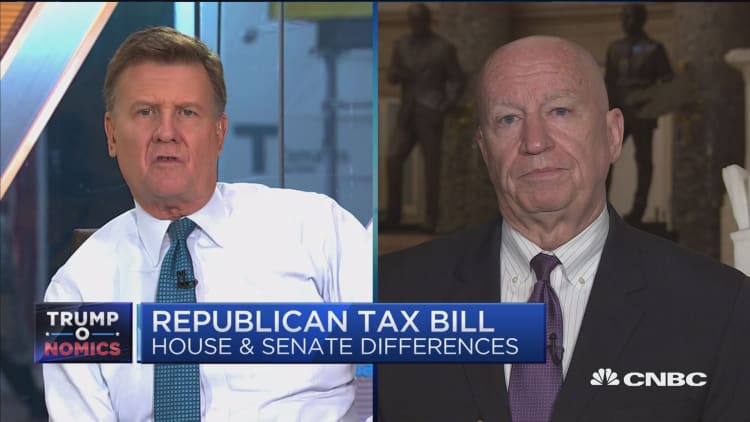
Many people shopping for Obamacare plans are unaware that Friday is the deadline for signing up in 41 states, even as demand for health plans is strong, a leading online insurance broker said Thursday.
EHealth CEO Scott Flanders told CNBC that a whopping 56 percent of consumers shopping for individual health plans sold on the company's website don't know of the looming deadline, which falls six weeks earlier than the last open-enrollment season.
Flanders said that lack of awareness, as well as widespread confusion among consumers about whether the Affordable Care Act remains the law — which it does — is likely to lead to a drop of 25 percent nationally in Obamacare enrollment for 2018 plans compared with the prior enrollment season.

"We believe that the minimum shortfall ... is 2 million" people, Flanders said.
Nationally, 12.2 million people signed up for an Obamacare plan sold on a government-run marketplace for 2017 coverage.
Despite Flanders' fears, traffic Thursday was strong on eHealth's site and on HealthCare.gov, the federally run Obamacare marketplace that serves 39 states, in advance of the deadline.
HealthCare.gov enrollment has since the beginning of the year outpaced the daily level of sign-ups last year — but not by enough to beat last year's season-end tally, given the earlier deadline this year.
"I expect it to be very strong tomorrow," Flanders said.
"But I'm still alarmed at all the consumers who are going to try to enroll Saturday or next week."
He said that because of that risk, he believes the Trump administration should extend the sign-up deadline into January.
So do two Democratic senators, Ron Wyden of Oregon and Patty Murray of Washington, who wrote senior Trump health officials and asked for an extension of the deadline to Jan. 31.
The left-leaning Center for American Progress joined that request Thursday saying, "With demand outpacing last year, the Trump administration's arbitrary decision to prematurely cut off enrollment this Friday will leave millions of Americans without coverage.'
"If enrollment falls far short of last year's total, which is likely, it will be a direct result of the Trump administration's decision to cut the open enrollment period in half," CAP said.
When asked for comment on the requests, the federal Centers for Medicare and Medicaid Services confirmed it had received the senators' letter and would respond.
A CMS spokeswoman said, "Consistent with our aim to have a seamless open enrollment experience for consumers this year, the [HealthCare.gov] website is performing well and consumers can easily access enrollment tools to compare plans and prices."
"The deadline for people to shop and pick a plan for the upcoming year is December 15," she said. "We continue to encourage people to make plan selections by that deadline so that their coverage can begin on January 1."
CMS noted that the Dec. 15 deadline was originally proposed by the Obama administration to take effect next year.
States that have later deadlines than HealthCare.gov states, along with Idaho and Vermont, are: California, Colorado, Connecticut, Maryland, Massachusetts, Minnesota, New York, Rhode Island and Washington, as well as the District of Columbia.
EHealth's Flanders said his company is seeing a marked drop-off in sales to younger adults for Obamacare plans.
"Our mix is shifting to older enrollees," he said.
Insurance plans prefer younger customers because they tend to use fewer health services while paying premiums that support benefits for older, sicker enrollees.
In another worrisome trend, eHealth has seen an unprecedented number of consumers going through the enrollment process only to drop out at the last page when they see how much they would have to pay in premiums.
"They can't believe the prices," Flanders said.
Many eHealth consumers earn too much to qualify for federal subsidies, or tax credits, that lower a customer's monthly premium. Most customers of government-run marketplaces qualify for such discounts.
EHealth's survey of its customers who receive a subsidy showed 36 percent are paying $100 or less per month for their Obamacare plans and 75 percent are paying $300 or less per month.
But among nonsubsidized customers, 36 percent are paying $1,000 or more per month for their coverage and 81 percent are paying $500 or more.
Flanders said higher premiums seen this year are spurring the exodus of younger customers.
However, Obamacare advocates have noted that this year more customers than ever are able to find a health plan that will cost them $0 per month personally after their subsidies are factored in.
The zero-dollar plans are more common, ironically, because of big price hikes for many individual health plans this year.
When prices of Obamacare plans rise, so do the value of the subsidies for qualified customers. In many cases, those subsidies will be worth more than the monthly premium price.
WATCH: Tax bill writer Brady expects final bill to repeal Obamacare mandate



